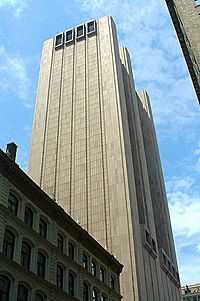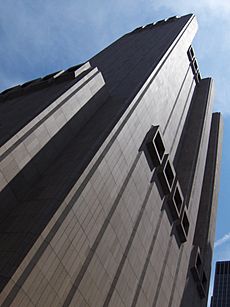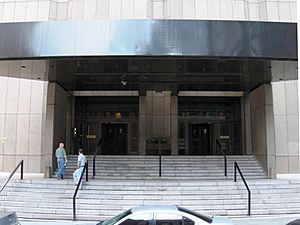33 Thomas Street facts for kids
Quick facts for kids 33 Thomas Street |
|
|---|---|
|
AT&T Long Lines Building
|
|
 |
|
| General information | |
| Status | Complete |
| Type | Utility |
| Architectural style | Brutalist |
| Location | Manhattan, New York City, New York, U.S. |
| Coordinates | 40°43′00″N 74°00′22″W / 40.71678°N 74.00610°W |
| Construction started | 1969 |
| Completed | 1974 |
| Opening | 1974 |
| Owner | AT&T |
| Height | |
| Roof | 550 ft (170 m) |
| Technical details | |
| Floor count | 29 |
| Design and construction | |
| Architect | John Carl Warnecke |
| Developer | AT&T |
33 Thomas Street is a very tall building in New York City. It is about 550 feet (168 meters) high. This skyscraper is in a part of Manhattan called Tribeca. It stands between Thomas Street and Worth Street.
The building used to be called the AT&T Long Lines Building. It has a unique look called Brutalist style. This means it uses a lot of concrete and has a strong, blocky shape. Its main job is to handle phone calls. It works as a central hub for long-distance calls. Some people also believe it might be a secret spy center for the US government.
Contents
History of the Building
This spot used to have old buildings made of cast-iron. These buildings were taken down carefully. Their fronts were saved before the new building was built. The 33 Thomas Street building was a key part of AT&T's phone network. It held special equipment for connecting phone calls. This equipment needed a very secure and large space.
AT&T slowly moved its phone systems here. They finished moving everything by 1999. The building still handles phone calls today. Some parts of it are also used as very secure data centers. These are places where computer servers store important information.
A Big Phone Outage
On September 17, 1991, something went wrong at 33 Thomas Street. A mix of problems caused a huge phone outage. Over 5 million phone calls were blocked. Even air traffic control for many airports was affected.
The building was designed to work on its own. It could switch from city power to its own generators. This was a normal thing they did. But this time, it didn't go as planned. After switching power, workers usually check all the equipment. This check was not done that day. Because of this, one power system ran only on batteries. The alarms were not noticed in time. This led to the big power failure.
After September 11, 2001
After the attacks on September 11, 2001, the World Trade Center was destroyed. Phone services that were based there were lost. AT&T moved these services to 33 Thomas Street. This helped restore phone connections for many people.
Building Design
The Long Lines Building was designed by John Carl Warnecke. It was finished in 1974. It was built to hold phone switching equipment. Because of this, each floor is very tall, about 18 feet high. This is much taller than in a normal office building. The floors are also extra strong. They can hold very heavy equipment.
The outside walls have no windows, except for the entrance. They are made of concrete panels. These panels are covered with special Swedish granite. The building has six large parts that stick out. These hold air ducts, stairs, and elevators. There are also big openings on the 10th and 29th floors for air to get in and out. Some people say it has the tallest blank wall in the world.
Many people think it is one of the safest buildings in America. It was built to be self-sufficient. This means it has its own gas and water. It can also make its own electricity. It was even designed to protect against nuclear fallout for up to two weeks. The New York Times newspaper said it "makes sense architecturally." They also said it "blends into its surroundings more gracefully" than other tall buildings nearby.
What the Building is Used For
The building is a telephone exchange. This means it connects phone calls. It used to have three main systems for long-distance calls. Two belonged to AT&T, and one belonged to Verizon. The Verizon system was removed in 2009. The building also has other systems for different phone companies.
Some people believe 33 Thomas Street is a secret NSA spy center. The NSA is a US government agency that collects information. This idea came from an investigation by The Intercept and a film called Project X. Both used information shared by Edward Snowden. Snowden revealed many details about government surveillance. The investigation suggests the building is linked to a nearby FBI building. It also links the building's rooftop equipment to the NSA's satellite intelligence system.
See also
 In Spanish: 33 Thomas Street para niños
In Spanish: 33 Thomas Street para niños



